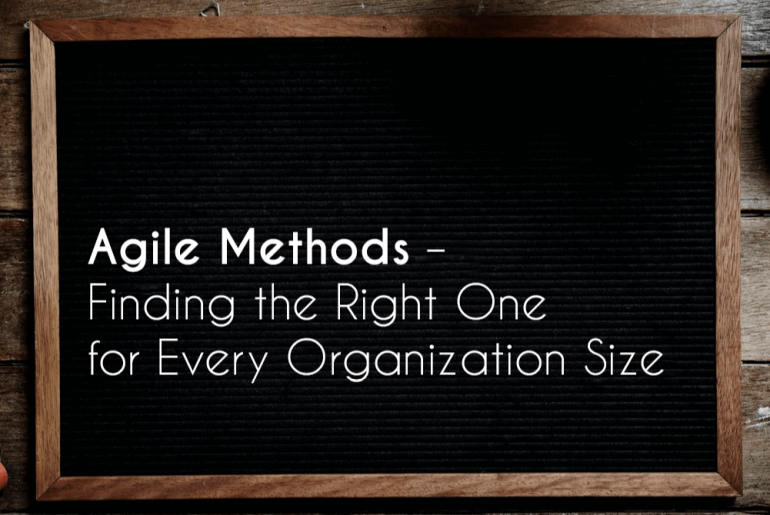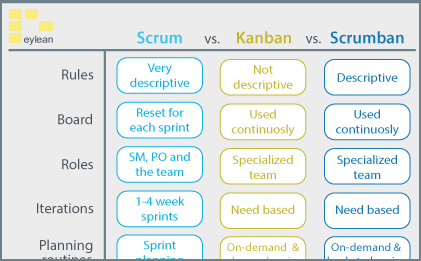A single team or a small company
If you work in an only team or a small company, it is relatively easy to apply Agile. However, it is always good to know where to begin.

Scrum
Scrum is one of the very first names that pop into your head when you think Agile, and there is a good reason for that. Contrary to many other methods, Scrum offers a great set of rules and an outline of how a project is supposed to run. You have clear roles, processes, and can easily fit them to your company to start working.
Unlike other Agile methods, Scrum is very descriptive and will fit a team that likes to go by the book. So if you want to know what’s happening at any specific point and wish to have a strictly set process, this is your choice.
Grab this Scrum cheat sheet to get started.
Kanban
On the other side of the small team application spectrum, we have Kanban. We can almost say that Kanban is the Agile counterpart to Scrum. Set to work for teams that need flexibility and the ability to change their process at any time. It offers planning on demand, ability to add new tasks into an ongoing iteration and team members deciding what to work on next.
So if your process is unpredictable or you have a very competent and independent team, this will be an excellent choice for you. Your team members will have to figure out a lot of the process details for themselves, but hey, they should enjoy that.
Get them this Kanban cheat sheet to put them onto the right track.
Scrumban
While Scrum and Kanban offer distinct different approaches to Agile project management, neither could be ideal for you. For teams that need both structure and flexibility, there is a third option – Scrumban. Blending the two methods, it allows for the process structure of Scrum and team member flexibility of Kanban to meet in a completely new approach.
It is excellent for teams that have tried Scrum and Kanban and found both of the methods lacking in some way. Mixing them allows for both defined processes and adoption to change.
Find out more about this blend with a Scrumban cheat sheet.
If you are still unsure which of the three small team methods is right for you, check out this table outlining the main points.
Several teams or mid-sized companies
If you work in a mid-sized company or an environment with several groups, the smaller methods will be harder to apply. For this reason, the Agile community has scaled Agile practices to fit the expanding needs.

SoS – Scrum of Scrums
This approach is ideal for those that like Scrum, but need to work with several teams. It organizes work in the same Scrum team way, having several teams within a company. And to make sure everything is coordinated, a new meeting by the name Scrum of Scrums is introduced. Held after the daily Scrums it includes one person from each team and aims to coordinate them towards the end goal.
So if you really like the structure of Scrum, but need to apply it in several coordinated teams at once, this is a great option. You will not have to learn new methodology or terms, simply scale what you are already doing to one additional meeting.
Learn more about the SoS method and apply it with your company.
LeSS – Large Scaled Scrum
Another scaled Scrum approach goes by the name of LeSS. The main difference from SoS is that all the teams of the company are using the same backlog in this case. Thus making it easier to oversee the project progress. Besides the same backlog, planning, client, and retrospective meetings are held together, and the daily scrums are open for all teams to attend.
While similar to SoS, LeSS sees the company as one team instead of several separate ones. You are making it easy to see the overall progress and present the finished result to clients while the coordination on a team level is a bit more complicated.
If this sounds like it could work for you, learn more about LeSS.
SLIM – Scrum Lean In Motion
Another approach for medium companies is not scaling Agile up to fit your processes, but scaling your operations down to fit Agile. When you think about it, no matter how big the company, it still has specific projects and products to produce. So instead of organizing work around the management structure, this offers to organize it around those projects.
If you are ready to let go of the management titles and structure, this could be a great fit that improves communication within your company. You will also greatly benefit from not needing to understand and implement a scaled Agile model, which may be difficult at times.
Learn more about this approach here.
Large companies
For those of you working in large organizations, adopting Agile will be the biggest challenge. It will require quite a significant organizational change. However, the following practices are tailor-made to soothe this transition.

SAFe – Scaled Agile Framework
The first option you have is SAFe. This method restructures the organization from the managerial levels into four levels of teams. You have team, program, value stream, and portfolio levels that are all working on a different scale, but towards the same goal delivering value to the result.
This approach keeps the concept of Agile teams but reorganizes to work on different scales – from production onto the long term planning. There are new terms and practices introduced to facilitate this approach, and it works quite well if you are willing to learn and adapt your ways.
Check it out in detail here.
DAD – Disciplined Agile Delivery
DAD is to SAFe what Kanban is to Scrum – a less descriptive and more flexible scaled Agile approach for large organizations. It expands the view of Scrum from only making and delivering the product into controlling its full life cycle. This way, ensuring that the teams not only execute sprints but stay on track to the long term vision of the company.
DAD divides the project into three stages – inception, construction, and transition. The inception phase is added to ensure the project is planned, and the vision is set ahead of execution. The construction phase is where the work gets completed. And the transition is added to allow alterations and changes before the finished product is handed off. The best thing is that teams get to choose the Agile process they want to use in the construction phase, and those can differ from team to team.
See the full description of DAD here.
WaterScrumFall
For those of you looking to keep some of the traditional project management practices in place and at the same time take advantage of Agile, WaterScrumFall may be a great choice. It blends the Waterfall and Scrum methods to deliver a mix that works both on the operational and managerial levels.
In this case, only Scrum is used where it is the most easily adaptable – team level. The project is planned, designed, and reviewed in the traditional waterfall approach, while Scrum is brought out in the analysis, development, and test phases. This allows for the operational teams to enjoy a better suited Agile approach, while management can stick with the preferred waterfall method.
Curious to see how this works? Find out here.






